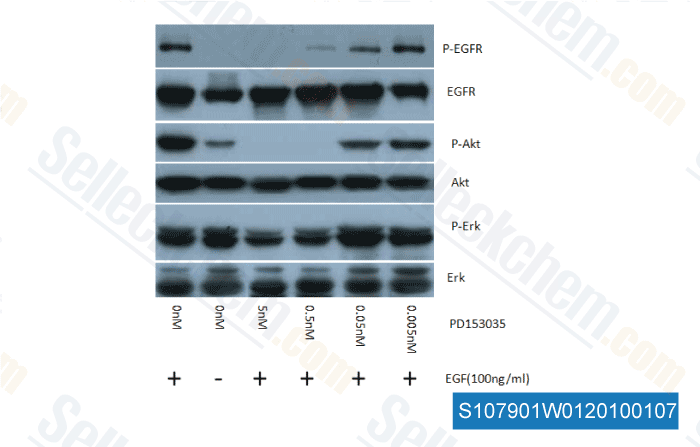|
Toll Free: (877) 796-6397 -- USA and Canada only -- |
Fax: +1-832-582-8590 Orders: +1-832-582-8158 |
Tech Support: +1-832-582-8158 Ext:3 Please provide your Order Number in the email. |
Technical Data
| Formula | C16H14BrN3O2.HCl |
||||||
| Molecular Weight | 396.67 | CAS No. | 183322-45-4 | ||||
| Solubility (25°C)* | In vitro | 4-Methylpyridine (warmed with 50ºC water bath) | 5 mg/mL (12.6 mM) | ||||
| DMSO | 0.5 mg/mL (1.26 mM) | ||||||
| Water | Insoluble | ||||||
| In vivo (Add solvents to the product individually and in order) |
|
||||||
|
* <1 mg/ml means slightly soluble or insoluble. * Please note that Selleck tests the solubility of all compounds in-house, and the actual solubility may differ slightly from published values. This is normal and is due to slight batch-to-batch variations. * Room temperature shipping (Stability testing shows this product can be shipped without any cooling measures.) |
|||||||
Preparing Stock Solutions
Biological Activity
| Description | PD153035 HCl (SU-5271 HCl, AG1517 HCl, ZM 252868 HCl) is a potent and specific inhibitor of EGFR with Ki and IC50 of 5.2 pM and 29 pM in cell-free assays; little effect noted against PGDFR, FGFR, CSF-1, InsR and Src. | ||
|---|---|---|---|
| Targets |
|
||
| In vitro | PD 153035 shows a potent and selective inhibitory effect on tyrosine phosphorylation induced with EGF with IC50 of 15 nM and 14 nM in Swiss 3T3 fibroblast and A-431 human epidermoid carcinoma cells, respectively. [1] PD153035 shows growth inhibitory effects in cultures of EGF receptor-overexpressing human cancer cell lines including A431, Difi, DU145, MDA-MB-468 and ME180 cells with IC50 of 0.22 μM, 0.3μM, 0.4 μM, 0.68 μM and 0.95 μM, respectively. [2] PD153035 induces a dose-dependent growth inhibition in nasopharyngeal carcinoma (NPC) cells including NPC-TW01, NPC-TW04, and HONE1 cell lines with IC50 of 12.9 μM, 9.8 μM and 18.6μM, respectively. [3] A recent study shows that PD153035 abolishes COX-2 expression induced by the PAR(2)-activating peptide 2-furoyl-LIGRLO-NH(2) (2fLI) in Caco-2 colon cancer cells. [4] | ||
| In vivo | In A431 human epidermoid tumors grown as xenografts in immunodeficient nude mice, PD153035 at 80 mg/kg inhibit EGF receptor tyrosine kinase activity. [5] PD153035 improves glucose tolerance, insulin sensitivity, and signaling and reduces subclinical inflammation in HFD-fed mice. [6] Pretreatment of EGFR inhibitors by 24 hours significantly enhances the cytotoxic effect of doxorubicin, paclitaxel, cisplatin, and 5-fluororuacil in NPCTW04 cells. [3] |
Protocol (from reference)
| Kinase Assay:[1] |
|
|---|---|
| Cell Assay:[2] |
|
| Animal Study:[5] |
|
References
Customer Product Validation

-
Data from [J Immunol, 2012, 188(9), 4581-4589 ]

-
, 2010, Dr. Zhang of Tianjin Medical University

-
Data from [Data independently produced by , , Oncotarget, 2016, 7(24):36168-36184.]
Selleck's PD153035 HCl has been cited by 18 publications
| Receptor-kinase EGFR-MAPK adaptor proteins mediate the epithelial response to Candida albicans via the cytolytic peptide toxin, candidalysin [ J Biol Chem, 2022, 298(10):102419] | PubMed: 36037968 |
| Hemodynamic Forces Regulate Cardiac Regeneration-Responsive Enhancer Activity during Ventricle Regeneration [ Int J Mol Sci, 2021, 22(8)3945] | PubMed: 33920448 |
| Identification of chemical compounds regulating PD-L1 by introducing HiBiT-tagged cells [ FEBS Lett, 2021, 595(5):563-576] | PubMed: 33421110 |
| Identification of chemical compounds regulating PD-L1 by introducing HiBiT-tagged cells [ FEBS Lett, 2021, 10.1002/1873-3468.14032] | PubMed: 33421110 |
| RAB31 marks and controls an ESCRT-independent exosome pathway [ Cell Res, 2020, 10.1038/s41422-020-00409-1] | PubMed: 32958903 |
| CD147 promotes collective invasion through cathepsin B in hepatocellular carcinoma [ J Exp Clin Cancer Res, 2020, 39(1):145] | PubMed: 32727598 |
| AREG mediates the epithelial‑mesenchymal transition in pancreatic cancer cells via the EGFR/ERK/NF‑κB signalling pathway. [ Oncol Rep, 2020, 43(5):1558-1568] | PubMed: 32323797 |
| Epidermal growth factor receptor inhibition attenuates non-alcoholic fatty liver disease in diet-induced obese mice [ PLoS One, 2019, 14(2):e0210828] | PubMed: 30735525 |
| Intelectin contributes to allergen-induced IL-25, IL-33, and TSLP expression and type 2 response in asthma and atopic dermatitis. [ Mucosal Immunol, 2017, 10(6):1491-1503] | PubMed: 28224996 |
| [ Oncotarget, 2016, ] | PubMed: 27556697 |
RETURN POLICY
Selleck Chemical’s Unconditional Return Policy ensures a smooth online shopping experience for our customers. If you are in any way unsatisfied with your purchase, you may return any item(s) within 7 days of receiving it. In the event of product quality issues, either protocol related or product related problems, you may return any item(s) within 365 days from the original purchase date. Please follow the instructions below when returning products.
SHIPPING AND STORAGE
Selleck products are transported at room temperature. If you receive the product at room temperature, please rest assured, the Selleck Quality Inspection Department has conducted experiments to verify that the normal temperature placement of one month will not affect the biological activity of powder products. After collecting, please store the product according to the requirements described in the datasheet. Most Selleck products are stable under the recommended conditions.
NOT FOR HUMAN, VETERINARY DIAGNOSTIC OR THERAPEUTIC USE.
